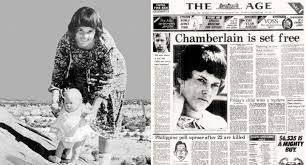Azaria Chamberlain Case: 'A Dingo's Got My Baby'

The Azaria Chamberlain case is one of the most controversial and widely-discussed criminal cases in Australian history. On the night of August 17, 1980, nine-week-old Azaria Chamberlain went missing from a campsite near Uluru, also known as Ayers Rock, in the Northern Territory of Australia. Her parents, Lindy and Michael Chamberlain claimed that a dingo,[ a wild dog native to Australia,] had taken her from their tent.
"A dingo's got my baby," Lindy Chamberlain told police and media of her daughter's disappearance.
According to Lindy, she put Azaria in her bassinet in the rear right corner of the tent, and Aidan settled into his sleeping bag. She said goodnight to Aidan and then he said he was still hungry. Lindy retrieved some baked beans from the car, which was parked near the tent, and went back to the BBQ area with Aidan. They were away from the tent for a period of 5 to 10 minutes.
When Lindy opened a can of beans, Michael and Mrs. Lowe both heard a brief, faint cry they suspected was from Azaria. Upon hearing the cry, Lindy went to investigate and saw a dingo, a wild dog in Australia, leaving the area with something in its mouth and shaking its head.
Lindy and Azaria Chamberlain at Uluru in August 1980. (Supplied)
She quickly ran into the tent to find that the baby was gone. Lindy's panicked cry of "the dingo has taken my baby" changed her from a homemaker to a news sensation. Despite the initial inquiry supporting the Chamberlains' claims and the conclusion by the Alice Springs magistrate and coroner Dennis Barritt that a dingo took Azaria.
But the Northern Territory police remained skeptical and accused Lindy of murdering her daughter in the front seat of their car. This led to the Supreme Court overturning the initial finding and charging Lindy with murder and Michael as an accessory.
Despite limited evidence, both Lindy and Michael were convicted, with Lindy receiving a life sentence on October 29, 1982. However, the evidence used against them, which was later discredited, was flawed and included supposed blood spatters in the family car's footwell and under the dash. This was later revealed to be a mistake in forensics.
According to National Museum of Australia curator Sophie Jensen, the evidence claimed to be Azaria's blood was found to be a variety of substances, including bitumen material (sound deadener used in the car's manufacturing), milkshake, and copper dust, but not blood.
Lindy was eventually released from prison in 1986 and exonerated, not because of a re-evaluation of the forensic evidence, but because Azaria's missing jacket was found near dingo dens at the base of Uluru in February 1986.
She and her husband Michael Chamberlain, co-accused, were officially pardoned in 1987, and their convictions were quashed by the Supreme Court of the Northern Territory in 1988. In 1992, the Australian government paid Chamberlain $1.3 million in compensation.
On June 12, 2012, the coroner expressed her emotions as she announced that Azaria had been killed by a dingo. She concluded by extending her condolences to the Chamberlains, saying: "Please accept my deepest sympathy for the loss of your beloved daughter. Time does not remove the pain and sadness of the death of a child.”
Coroner Elizabeth Morris officially determined the death of Azaria was by a dingo and granted an amended death certificate to Lindy and Michael.
The case generated immense public interest and even near hysteria, becoming one of the most widely publicized trials in Australian history and dividing the community. Over the years, the case has inspired numerous books, TV documentaries, a film, and even an opera about the case.

 My First News Item
My First News Item My Nine News Item
My Nine News Item